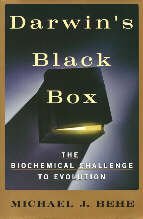The Design's in the Details
The Design's in the Details
 Michael J. Behe (1996), Darwin’s Black Box: The Biochemical Challenge to Evolution (New York: The Free Press), hardbound, 307 pages, $25.00.
Michael J. Behe (1996), Darwin’s Black Box: The Biochemical Challenge to Evolution (New York: The Free Press), hardbound, 307 pages, $25.00.
Hailed by some as a coup for the cause of creation, this eagerly-awaited book does not disappoint. Michael Behe, associate professor of biochemistry at Lehigh University, unabashedly argues a case for intelligent design in life. Others have tackled this same argument, but Behe breaks new ground in having his book printed by a division of a major publishing company (Simon & Schuster).
Behe presents three major points. First, he argues that evolution has to go further in explaining the origin of complete structures or organs. Currently, evolutionary speculations involve nothing more than arranging or rearranging a stockpile of preexisting components. Perhaps, following the most vociferous opponents of design such as Richard Dawkins, evolutionists could argue that the nerve cell, retina, cornea, and other parts of the eye came together accidentally. They may even offer a seemingly persuasive scenario whereby this occurred in gradual, successive steps. But this is woefully inadequate, Behe argues.
Following the title motif, the author likens the eye to a kind of black box, and its components to a series of smaller black boxes. A “black box” is a term drawn from the world of modern machines. It is something very complicated that an average mechanic will not touch. He will unplug it, send it away to the factory for repair, and replace it, but he will never open it up to fix anything inside. Someone could go to an airplane, for example, remove the black boxes, put them together with some fresh aluminum sheets and parts from other airplanes, and create a whole “new” design. But he will get nowhere without those preexisting, highly complicated black boxes. When special kinds of scientists—people such as biochemists—open up the black boxes of molecular machines, blood coagulation, and the metabolic pathway (to mention some of Behe’s favorite examples), they fail to find still smaller black boxes. At some point they run into “irreducible complexity”—a single system which, if any part were removed or crippled, would cease to perform its obvious function. But Behe does not merely throw down the gauntlet and walk away. He devotes considerable space to describing the irreducible complexity of the preceding examples, and shows the difficulty in explaining these systems by any sort of blind, unthinking, natural process.
In the second part of the book, Behe takes an unusual approach. He starts out by trying to find the evolutionists’ explanations for any complex biochemical system. A comprehensive search in a seemingly promising source, the Journal of Molecular Evolution, turns up very few attempts to explain the evolution of such systems. Some papers offer very imaginative, or very simplistic, solutions, but none offers a detailed Darwinian model. Behe broadens his search to other likely journals and textbooks, with the same result. He concludes that molecular evolution has not published and, therefore, it should perish.
Finally, Behe tries to establish that the search for intelligent design is possible without ruining science. He eliminates a couple of non-Darwinian, but naturalistic, proposals, and concludes that intelligent design is the only explanation for the irreducible complexity he observes. But the author also draws a distinction between the claims for design or evolution, and scientific proof for such claims. Presumably, Behe would expect to find many examples of design throughout nature, but he urges fellow scientists to look at each organism, part of an organism, or intricate system within the living world, on a case-by-case basis.
Overall, the book is very well-written and presented. Technical descriptions not crucial to the argument are set aside in specially-marked sections, and Behe (with some good editors, no doubt) has done a good job at writing on as popular a level as possible. The author does not hide his belief in God, but a few brief, sporadic comments indicate a desire to distance himself from young-Earth creationism. Perhaps these were intended to make the book more marketable, but they were unnecessary because Behe’s arguments stand without any reference to the age issue. Nonetheless, everyone should catch this glimpse of a design argument for the new millennium.
[For a somewhat objective critique of Darwin’s Black Box by an evolutionist, with responses, see The Boston Review. For further reactions from evolutionists (especially ultra-Darwinists), see the (unofficial) Richard Dawkins site.]

REPRODUCTION & DISCLAIMERS: We are happy to grant permission for this article to be reproduced in part or in its entirety, as long as our stipulations are observed.


0 Comments:
Post a Comment
<< Home